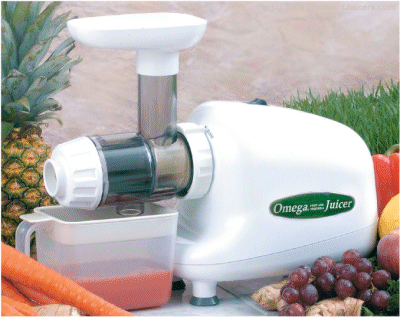|
Breville MULTI-SPEED 900-WATT JUICER
|
VS |
|
Today, we will be testing two different juicers.Firstly, the centrifugal juicer, the Breville MULTI-SPEED 900-WATT JUICER.Secondly, the masticating juicer, the Omega Nutrition Center 8003.
The centrifugal juicer works by having a feed tube on top that is 3-4 inches in diameter. The ingredients are inserted into the machine through this opening, which contains rotating blades that operate at speeds ranging from 6,500 to 13,000 revolutions per minute.
A key benefit of the centrifugal juicer is its ability to effectively separate the extracted juice from the waste, ensuring that the outlet remains unobstructed. This feature simplifies the process of installation, removal, and cleaning.
For ingredients that require more forceful preparation, such as carrots and beets, the machine's adjustable speed settings allow for optimal grinding.The juicer's rapid juicing speed is a key feature, with a machine tested today capable of extracting 1 kg of carrots in approximately 25 seconds.
Another machine with competing technology, known as the masticating juicer, works by pressing the juiced product into a pulp, squeezing it into a very small area, and then flowing it out through a fine mesh.It has an auger inside the machine, which is pressed through an auger table rotating at 80-100 revolutions per minute.
The juicer is equipped with a high-performance motor that delivers a high torque, enabling it to rotate the auger table and press the food through the fine mesh.While centrifugal juicers typically operate at a faster speed, masticating juicers offer greater juice extraction potential.

We also prepared some ingredients, respectively, ORANGE, CARROT, KALE
First of all, the first round of testing, we put 240G of oranges into our 2 juicers, we can obviously see that Breville's juicing speed is much faster, and then OMEGA's juice cup is obviously smaller, the pulp and the juice can only choose one of them to follow, which makes the scene! The OMEGA's juice cups are obviously smaller and the pulp and juice could only be picked up by one or the other, which made for an awkward situation and a lot of juice dripping onto the tester.
Let's take a look at the centrifuge's pulp, which is apparently still wet, compared to the masticating juicer's pulp, which is much drier, and the tester ate a piece and said, ‘only cellulose pomace is left’. Haha, clearly the OMEGA juice cups are superior in terms of purity of extraction.
Let's take a look at the comparison between the 2 cups of juice, first of all, color wise, the centrifugal juicer's juice had a higher consistency, however the masticating juicer's consistency was taught to be lower, think of the purity of the masticating juicer compared to the masticating juicer. The TROPICANA concentrate, which is a nice bright orange color.
In the second test, 200 grams of carrots were juiced at an increased centrifugal juicer speed due to the slightly harder nature of the ingredients.
The test began, and interestingly, both juicers extracted 200g of carrot juice at a similar speed. Omega's carrot pomace was found to be dry and flaky, while Breville's carrot pomace was still finely chopped, but the dryness of the pomace remained consistent between the two machines for this carrot test. Carrot pomace is rich in dietary fibre and vitamins, and can be used in a variety of dishes.The colour of the juice from each machine was consistently similar, with the Breville juice displaying a slight foamy consistency, indicating oxidation.
The third test involved a kale juice, which was juiced with 120g of kale.
We always recommend cutting the kale into circles and then sprinkling olive oil, salt and pepper on top before baking to crisp it up, similar to how you would prepare a potato. Alternatively, you can consume the kale juice, which is also very tasty.
Kale is a highly fibrous vegetable, so it is recommended that it is cut up and placed in segments in order to avoid making a mess. The juice that is extracted from kale is a vibrant green colour, reminiscent of Irish Spring vegetable juice. This is an effective method of consuming vegetables on a daily basis, particularly for individuals who do not generally consume large quantities of vegetables.
The juicing process yielded 120 grams of kale juice, which is notably more vegetable juice than the masticating juicer produces.The tester sampled the juice and found it to have a refreshing, lawn-mowing flavor.
The 3-way test demonstrated that the masticating juicer is challenging to clean, as it filters the juice through a screen. This can lead to clogging, particularly when juicing root vegetables, which can be difficult to clean. In contrast, a centrifugal juicer utilises high speeds to separate the fibres, resulting in a more efficient extraction process. These juicers are often equipped with a separator that holds the pulp, simplifying the cleaning process.





Share:
The Best Juicer Machine in 2025
Is the Ninja Slushie Machine worth to buy